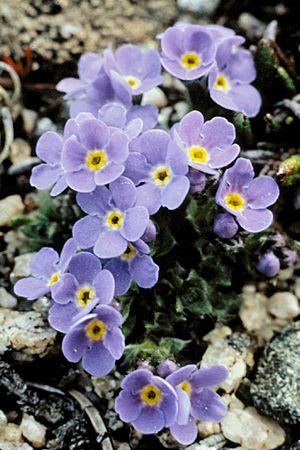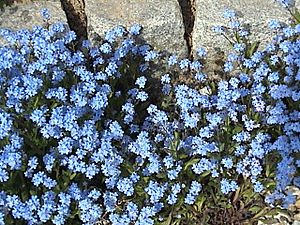Forget-me-not facts for kids
Quick facts for kids Forget-me-nots |
|
|---|---|
 |
|
| Alpine Forget-me-not | |
| Scientific classification | |
| Kingdom: | |
| (unranked): | |
| (unranked): | |
| (unranked): | |
| Order: |
(unplaced)
|
| Family: | |
| Genus: |
Myosotis
|
| Species | |
|
about 50 |
|
Myosotis (from the Greek: μυοσωτίς "mouse's ear", after the leaf) is a genus of flowering plants in the family Boraginaceae.
In the northern hemisphere they are commonly called forget-me-nots or scorpion grasses. The common name "forget-me-not" was calqued from the German Vergissmeinnicht, and first used in English in 1398 AD via King Henry IV. Similar names and variations are found in many languages. Myosotis alpestris is the state flower of Alaska and Dalsland Sweden. Plants of this genus are commonly confused with Chatham Islands forget-me-nots which belong to a related genus, Myosotidium.
Distribution
Over five hundred species names have been recorded, but there are only 74 accepted species. The rest are either synonyms of currently accepted names or submissions awaiting resolution.
The genus is largely restricted to two discrete geographic centres: western Eurasia with about 60 confirmed species and New Zealand with around 40 confirmed species. Very small numbers of species occur elsewhere including North America, South America, and Papua New Guinea. Despite this, Myosotis species are now common throughout temperate latitudes via the planting of cultivars and introductions of alien species. Many are popular in gardens, preferring moist habitats. In areas where they are not native, they have frequently escaped to wetlands and riverbanks. Only those native to the Northern hemisphere are commonly called Forget-me-not.
It is equally possible that the genus originated in either the Northern Hemisphere or in New Zealand. One or two European species, especially the wood forget-me-not, Myosotis sylvatica have been introduced into most of the temperate regions of Europe, Asia, and the Americas.
Morphology
Myosotis have 5-merous actinomorphic flowers with 5 sepals and petals. Flowers are typically 1 cm diameter (or less), flat, and blue, pink, white or yellow with yellow centres, growing on scorpioid cymes. They may be annual or perennial with alternate leaves. They typically flower in spring or soon after snow-melt in alpine eco-systems. Their root systems are generally diffuse.
Their seeds are found in small, tulip-shaped pods along the stem to the flower. The pods attach to clothing when brushed against and eventually fall off, leaving the small seed within the pod to germinate elsewhere. Seeds can be collected by putting a piece of paper under the stems and shaking the seed pods and some seeds will fall out.
Myosotis scorpioides is also known as scorpion grass due to the spiraling curve of its inflorescence.
In popular culture
- In a German legend, God named all the plants when a tiny unnamed one cried out, "Forget-me-not, O Lord!" God replied, "That shall be your name."
- In another Greek legend, when the Creator thought he had finished giving the flowers their colours, he heard one whisper "Forget me not!" There was nothing left but a very small amount of blue, but the forget-me-not was delighted to wear such a light blue shade.
- In medieval times, it was often worn by ladies as a sign of faithfulness and enduring love.
- Henry IV adopted the flower as his symbol during his exile in 1398, and retained the symbol upon his return to England the following year.
- In 15th-century Germany, it was supposed that the wearers of the flower would not be forgotten by their lovers.
- Freemasons began using the flower in 1926 as a symbol not to forget the poor and desperate. In later years, it was a means of recognition in place of the square and compass design. Some also use it to remember those Masons who were victimized by the Nazi regime. In recent years, it is more commonly worn to remember those who have died as a symbol that they may be gone but, but they are not forgotten.
- Henry David Thoreau wrote, "The mouse-ear forget-me-not, Myosotis laxa, has now extended its racemes very much, and hangs over the edge of the brook. It is one of the most interesting minute flowers. It is the more beautiful for being small and unpretending; even flowers must be modest."
- In his description of his original design for the Flag of Alaska, Benny Benson stated, "The blue field is for the Alaska sky and the forget-me-not, an Alaskan flower."
- In 1949, Newfoundland (then a separate British Dominion) used the forget-me-not as a symbol of remembrance of that nation's war dead. This practice is still in limited use today, though Newfoundlanders have adopted the Flanders Poppy as well.
Images for kids
See also
 In Spanish: Nomeolvides (planta) para niños
In Spanish: Nomeolvides (planta) para niños









